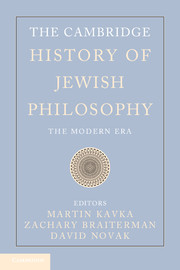Book contents
- Frontmatter
- Contents
- Contributors
- Acknowledgement
- Introduction
- I Judaism's Encounter with Modernity
- II Retrieving Tradition
- III Modern Jewish Philosophical Theology
- IV Jewish Peoplehood
- V Issues in Modern Jewish Philosophy
- 21 Reason as a Paradigm in Jewish Philosophy
- 22 Imagination and the Theolatrous Impulse: Configuring God in Modern Jewish Thought
- 23 Justice
- 24 Virtue
- 25 Aesthetics and Art
- 26 Interpretation, Modernity, and the Philosophy of Judaism
- Bibliography
- Index
25 - Aesthetics and Art
from V - Issues in Modern Jewish Philosophy
Published online by Cambridge University Press: 28 September 2012
- Frontmatter
- Contents
- Contributors
- Acknowledgement
- Introduction
- I Judaism's Encounter with Modernity
- II Retrieving Tradition
- III Modern Jewish Philosophical Theology
- IV Jewish Peoplehood
- V Issues in Modern Jewish Philosophy
- 21 Reason as a Paradigm in Jewish Philosophy
- 22 Imagination and the Theolatrous Impulse: Configuring God in Modern Jewish Thought
- 23 Justice
- 24 Virtue
- 25 Aesthetics and Art
- 26 Interpretation, Modernity, and the Philosophy of Judaism
- Bibliography
- Index
Summary
The modern discourse on “Jewish art” and aesthetics, like recent discourse on art itself, has been profoundly conscious of its need for self-legitimation. One cannot speak of “Jewish art,” it seems, without resolving the “contradiction in terms” that is associated with its concept. This supposed contradiction, however, though it appears to be validated, to some measure, by ancient and early modern Judaism's relatively sparse heritage of figural art (as compared for instance to the Greco-Roman or Catholic traditions), is primarily the result of a modern polemical discourse on the possibility of national art in general and of Jewish art in particular. When the art historian Bernard Berenson, himself a Jewish immigrant from Lithuania whose late diaries invoke a “Talmudic feeling” and strong affinities to the nascent State of Israel, wrote in 1953 that “Israel through the ages has manifested nothing essentially national in the plastic arts, neither in antiquity nor through the Middle Ages, nor to-day,” he attested to the absence of Jewish art on the basis of lacking Jewish style and originality: “Even in recent years,” writes Berenson, “when Jews emancipated from the Ghetto have taken in painting and sculpture and architecture, they have proved neither original nor in the least Jewish.” For this historian of Italian Renaissance art (Berenson's field of expertise), the history of Jewish art production naturally remained outside the classical canon shaping Western aesthetics; unlike Renaissance art, Jewish art also offered little stylistic coherence that would allow for its national classification or collective originality.
- Type
- Chapter
- Information
- The Cambridge History of Jewish PhilosophyThe Modern Era, pp. 759 - 779Publisher: Cambridge University PressPrint publication year: 2012

